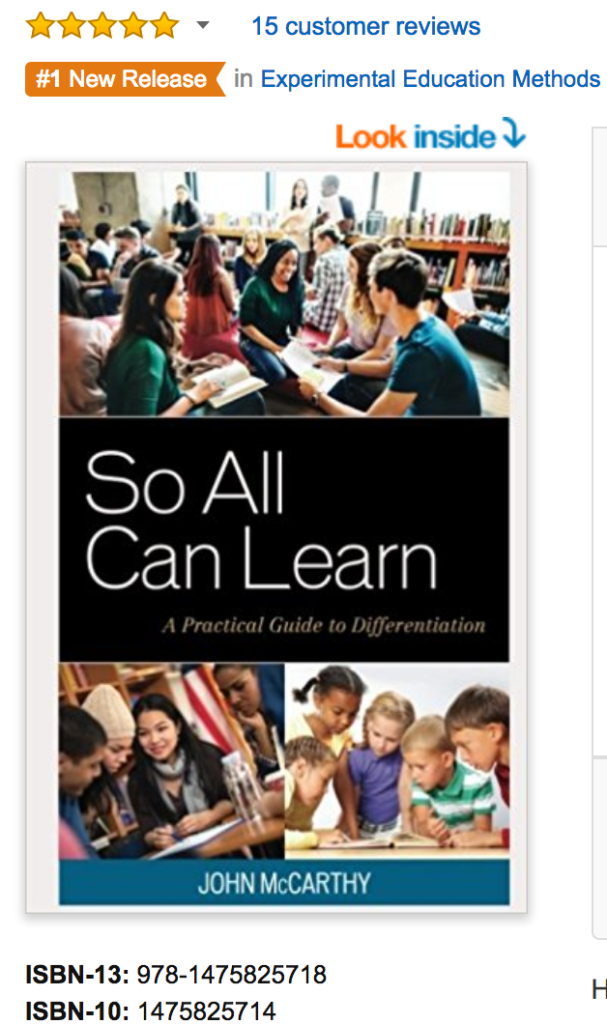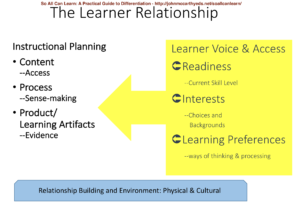In the past, I’ve written several articles about the myths that prevents many teachers from using Differentiation as an integral part of how they meet learner needs.
- Myth-Busting Differentiated Instruction: 3 Myths and 3 Truths
- There’s No Time to Differentiate: Myth Busting DI, Part 2
- Differentiating is just too difficult: Myth-Busting DI Part III
- Teachers Are in Control: Myth-Busting DI
- Mythbusting Differentiation: Solutions to Make Differentiation a Reality
They have resonated with educators who comment and share these articles with colleagues. I often hear how the articles empowered or gave teachers permission to do more. Best of all, most express finding affirmation for what they are already doing, which is one intention of these articles: Teachers do differentiate, whether unconsciously or with deliberation.
It’s time to change the focus from the myths to the truths. What are the realities for Differentiation?
There are many. Here is the first:
Differentiation starts with learners.
The standard language for Differentiation was introduced early on by Carol Ann Tomlinson and Susan Allan in books in 1999 and 2001. It’s a language that continues to work today, as I note in So All Can Learn: A Practical Guide to Differentiation.
Teachers often start with Content, Process, and Products as those are the vehicles for differentiating learning experiences.
It makes sense to begin with these three elements because they are most familiar to educators when it comes to planning instruction. Richard DuFour, among many respected education thinkers, described these steps as:
- What do students need to know, understand, and do?
- How will students demonstrate what they’ve learned and not learned?
- What will we do for students who fail?
- What will we do for students who’ve already learned the content and concepts?
Despite all this information, instruction begins with the learner through Readiness, Interests, and Learning Preferences.
The student is best equipped to make connections or determine if the lesson is best for them. They do this all the time through expressions of engagement to disengagement.
What motivates learners to participate? What engages students to dedicate time and energy into the lessons? The answers can only come from them. The solution for teachers is to make the conscious decision to communicate and collaborate with students, including them in the planning and decision-making of the learning experiences based on Readiness, Interests, and Learning Preferences. If this feels uncomfortable, or the voice in your head is giving excuses for why this cannot be done, then you understand what your struggling learners feel about your lessons.
Starting places:
- Use a Learning Preference inventory to help craft 2-4 choices that students might opt to complete tasks. Bonus points if you then get their feedback about the choices, and make revisions based on their input.
- Collect formative assessment data and use it to craft variations of the same task so that students can be assigned or choose the appropriate level. Make sure that each task includes critical thinking and is respectful to the learner. Every student can analyze, evaluate, and synthesize, even with very basic understanding. Over simplifying work that’s stuck at the comprehension and fact-base level for struggling learners insults their intelligence. Again, bonus points if you get their feedback about the choices, and make revisions based on their input.
- Clearly explain and coach the learning outcomes so that students understand them and what is expected of them. Then support students as they construct products of their design that demonstrate the learning outcomes.
Find more related resources from So All Can Learn: A Practical Guide to Differentiation.
Stay tuned for more Truths about Differentiation and Learning…
Repost from JohnMcCarthy.net


